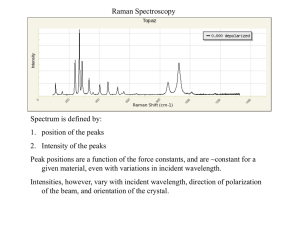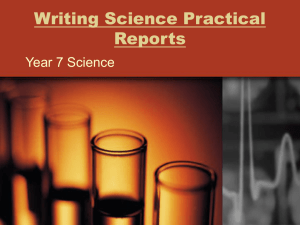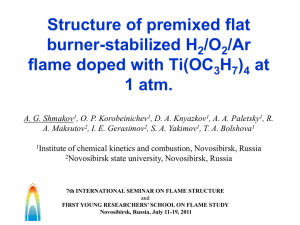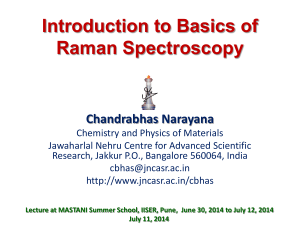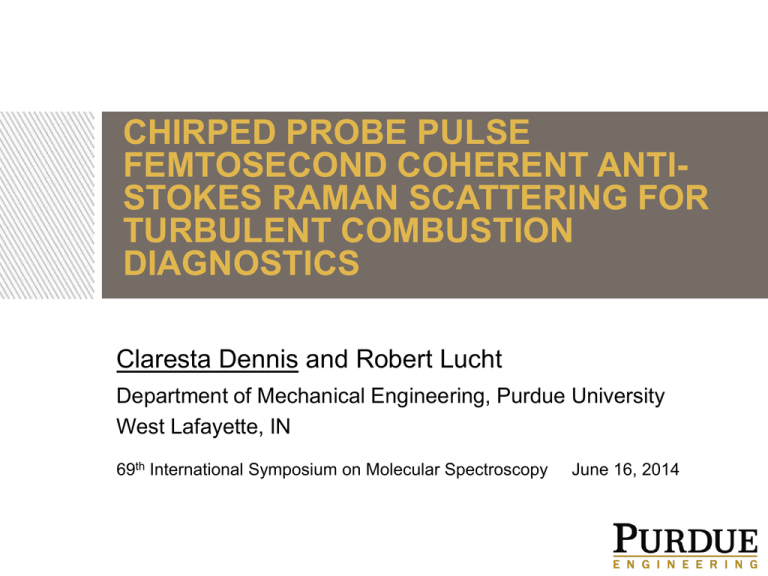
CHIRPED PROBE PULSE
FEMTOSECOND COHERENT ANTISTOKES RAMAN SCATTERING FOR
TURBULENT COMBUSTION
DIAGNOSTICS
Claresta Dennis and Robert Lucht
Department of Mechanical Engineering, Purdue University
West Lafayette, IN
69th International Symposium on Molecular Spectroscopy
June 16, 2014
INTRODUCTION
TURBULENT COMBUSTION DIAGNOSTICS
John Zink Ultra
Low Emission
Burner
Mitsubishi 1700 Class
Gas Turbine
John Zink Hamworthy Combustion
http://www.johnzink.com/applications/ethyle
ne-applications/
Non-intrusive laser based
spectroscopy methods are ideal
N. Oshima, T. Tominaga, K.
Saito, Proc. Symposium on
Power Ener. Engr., 2008; 6.
INTRODUCTION
COHERENT ANTI-STOKES RAMAN SCATTERING
INTRODUCTION
CHIRPED PROBE PULSE FEMTOSECOND CARS
EXPERIMENTAL SYSTEM
Ti:Sapphire Laser Output
10.2 W average power
60 fs duration laser pulses
800 nm center wavelength
~400 cm-1 bandwidth
CALIBRATION FLAME
Hencken burner – stable,
uniform, near-adiabatic H2/air
flame
25 mm square fine honeycomb
structure with protruding
hypodermic needles
Volumetric flow rates of fuel and
oxidizer controlled to produced
specific flame temperatures
Frequency / cm -1
Frequency / cm-1
http://www-personal.umich.edu/~mswool/facilities.htm
Frequency / cm-1
Frequency / cm-1
SPECTRAL MODELING
2000 shots averaged
and background
subtracted
Fix flame
temperature
Hencken burner spectrum
Single
Hencken
burner
spectrum
Hencken burner spectrum
Hencken burner spectrum
Hencken burner spectrum
Hencken burner spectrum
Laser
Parameters
Laser Beam
Power Spectra
Temperature,
scaling factors
floated
Laser
Parameters
Genetic
Algorithm
Based Spectral
Fitting Code
Single Shot
Genetic
Algorithm
Based Spectral
Fitting Code
Accuracy of temperature measurements is
affected by the accuracy of calculated laser
parameters and accuracy of the reference
flame temperature
Vibrational N2 CPP fs-CARS
temperature measurements
at 5 kHz
PRECISION AND ACCURACY
Histograms from 2000 single
laser shot measurements in
Hencken burner
Typical values:
precision better than 2%
accuracy ~ 3%
Precision and accuracy
improve increasing
temperature
RESULTS
JET DIFFUSION FLAME
Jet nozzle exit diameter = 5 mm
Co-flow exit diameter = 160 mm
9 SLPM (7.7 m/s) of hydrogen
180 SLPM (0.15 m/s) of laboratory
shop-air
RESULTS
JET DIFFUSION FLAME
RESULTS
DLR GTMC DUAL SWIRL BURNER
Many previous studies: PLIF of OH, CH and H2CO, laser
Doppler anemometry (LDA), OH* chemiluminescence
imaging, Raman scattering, two-line OH PLIF thermometry,
and stereoscopic PIV
Operated at “Flame V” condition
Global Equivalence Ratio = 0.65
Adiabatic Flame Temperature = 1660 K
RESULTS
DLR GTMC DUAL SWIRL BURNER
RESULTS
DLR GTMC DUAL SWIRL BURNER
Performed PSD analysis to compare with
previous thermo-acoustic measurements
25,000 single-laser-shot fs-CARS
measurements used
Observed power spectrum peaks at 176,
308, 485, 796-805 Hz
308 Hz = frequency of dominant
longitudinal thermo-acoustic pulsation
485 Hz = precessing vortex core
Agrees with previous studies where
PVC frequency occurred at 515 Hz
I. Boxx, M. Stöhr, C. Carter, W. Meier, Combust. Flame, 2010; 157, 1510-1525.
CONCLUSIONS
Successfully demonstrated CPP fs-CARS in turbulent combustor of practical interest
Excellent spatial resolution and improved accuracy/precision over ns-CARS
measurements
Future work:
Improve the technique’s dynamic range by splitting the CARS signal into two detector
channels (two spectrometers, two EMCCD cameras)
ACKNOWLEDGMENTS
Dr. Isaac Boxx and Dr. Wolfgang Meier from DLR Sttutgart
Devashish Bangar, Dr. Carson Slabaugh, Dr. Aman Satija
Funding provided by US Department of Energy, Division of Chemical Sciences,
Geosciences, and Biosciences
Ultrafast laser system purchased with funding from an AFOSR DURIP grant
Naval Air Warfare Center Graduate Research Fellowship
QUESTIONS?
BACKUP
First demonstrated by Lang and Motzkus*
Allows single laser shot measurements
Chirped Probe Pulse
2-3 psec
Probe Beam - 3
800 nm, 60 fs, 90 J
Dispersive
Rod
60 cm SF11
Delay Line
for Probe
Stokes Beam - 2
800 nm, 60 fs, 70 J
Pump Beam - 1
674 nm, 60 fs, 50 J
Raman Coherence
CARS Signal Beam - 4
Turbulent Flame
or Gas Cell
To Spectrometer
and EMCCD
t
D. R. Richardson, R. P. Lucht, W. D. Kulatilaka, S. Roy, J. R. Gord, Appl. Phys. B, 2011, 104.
*T. Lang and M. Motzkus, J. Opt. Soc. Am. B, 2002, 19.
BACKUP
CHIRPED PROBE PULSE FEMTOSECOND COHERENT ANTI-STOKES
RAMAN SCATTERING FOR TURBULENT COMBUSTION DIAGNOSTICS
Ultrafast lasers are inherently broadband, create stronger Raman coherence in medium
Measurements are acquired over timescales faster than molecular collisions occur
Solid state laser, excellent spatial mode, no shot-to-shot fluctuations in laser spectrum
Nanosecond laser-based Raman excitation
J. R. Gord, T. R. Meyer, S. Roy, Ann. Rev. Anal. Chem. 2008 ; 1.
Femtosecond laser-based Raman excitation







